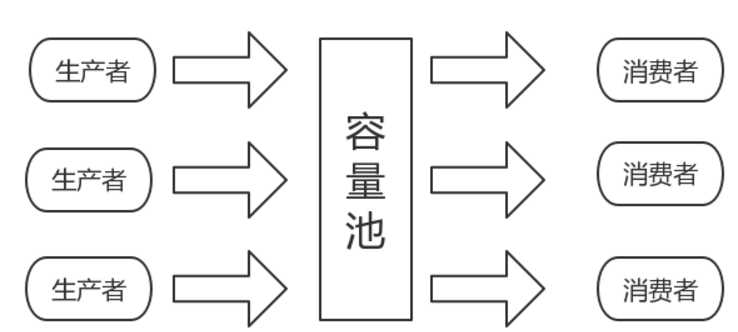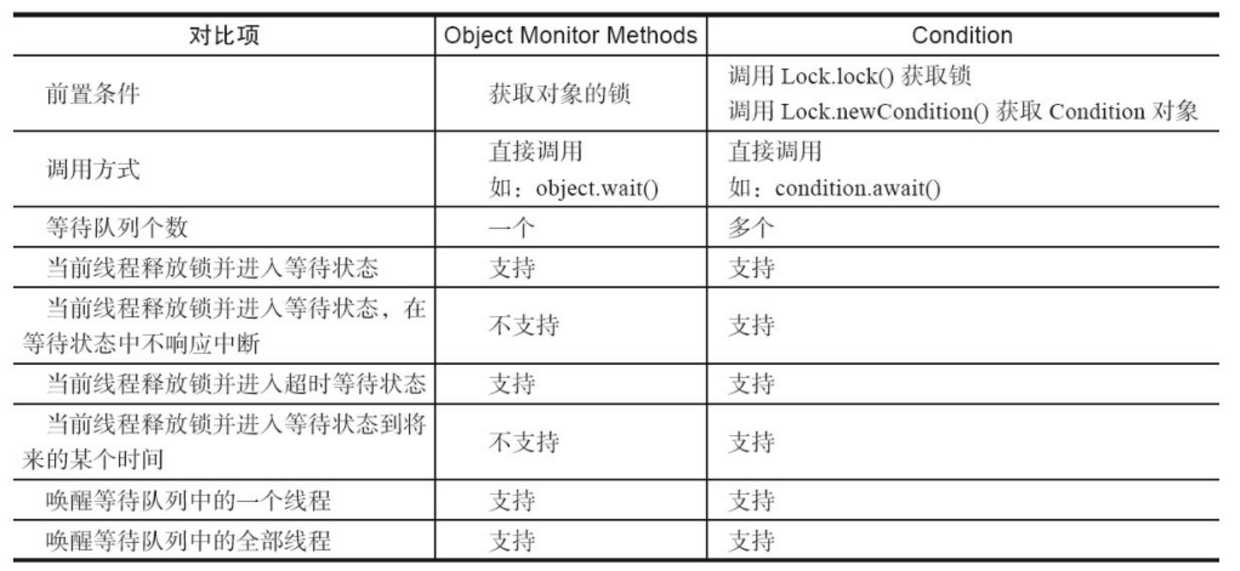标签:mic ber stat 特性 sys finally ISE 监视器 ring
/**
* 使用Synchronized实现消费者生产者模式
*/
public class SynchronizedDemo {
static List<Integer> list = new ArrayList<Integer>();
private static int maxNum = 5;
// 消费者
private void Consumer(String name){
synchronized (list){
while(list.isEmpty()){
// 如果list为空,调用wait等待,并且释放锁
try {
System.out.println("----当前产品数量为0个,"+name+"无法消费");
list.wait();
} catch (InterruptedException e) {
e.printStackTrace();
}
}
list.remove(0);
System.out.println("当前产品数量为"+list.size()+"个,"+name+"消费1个产品");
list.notifyAll();
}
}
// 生产者
private void Producer(String name){
synchronized (list){
while(list.size()>maxNum){
// 如果list容量大于5个,那么就等待,直到有空余容量再生产产品
try {
System.out.println("++++当前容量已满,"+name+"无法生产");
list.wait();
} catch (InterruptedException e) {
e.printStackTrace();
}
}
list.add(1);
System.out.println("当前容量为,"+list.size()+","+name+"生产1个产品");
list.notifyAll();
}
}
public static void main(String[] args) throws InterruptedException {
SynchronizedDemo demo = new SynchronizedDemo();
Thread consumer1 = new Thread(()->demo.Consumer("consumer1"));
Thread consumer2 = new Thread(()->demo.Consumer("consumer2"));
Thread consumer3 = new Thread(()->demo.Consumer("consumer3"));
Thread consumer4 = new Thread(()->demo.Consumer("consumer4"));
Thread producer1 = new Thread(()->demo.Producer("producer1"));
Thread producer2 = new Thread(()->demo.Producer("producer2"));
Thread producer3 = new Thread(()->demo.Producer("producer3"));
Thread producer4 = new Thread(()->demo.Producer("producer4"));
consumer1.start();
consumer2.start();
consumer3.start();
consumer4.start();
producer1.start();
producer2.start();
producer3.start();
producer4.start();
TimeUnit.SECONDS.sleep(5);
System.out.println("最后剩余多少个产品:"+demo.list.size());
}
}

如上图,假设有一个公共的容量有限的池子,有两种人,一种是生产者,另一种是消费者。需要满足如下条件:
注意:
????任意一个Java对象,都拥有一组监视器方法(定义在java.lang.Object上),主要包括wait()、wait(long timeout)、notify()以及notifyAll()方法,这些方法与synchronized同步关键字配合,可以
实现等待/通知模式。Condition接口也提供了类似Object的监视器方法,与Lock配合可以实现等待/通知模式,但是这两者在使用方式以及功能特性上还是有差别的。
Object的监视器方法与Condition接口的对比:

????Condition定义了等待/通知两种类型的方法,当前线程调用这些方法时,需要提前获取到
Condition对象关联的锁。Condition对象是由Lock对象(调用Lock对象的newCondition()方法)创
建出来的,换句话说,Condition是依赖Lock对象的。
使用Condition接口改写上面的消费者生产者代码:
/**
* 使用Condition实现消费者生产者模式
*/
public class ConditionDemo {
static List<Integer> list = new ArrayList<Integer>();
static ReentrantLock lock = new ReentrantLock();
static Condition condition = lock.newCondition();
private static int maxNum = 5;
// 消费者
private void Consumer(String name){
lock.lock();
try{
while(list.isEmpty()){
System.out.println("----当前产品数量为0个,"+name+"进入等待队列");
condition.await();
}
list.remove(0);
System.out.println("当前产品数量为"+list.size()+"个,"+name+"消费1个产品");
condition.signal();
} catch (InterruptedException e) {
e.printStackTrace();
}finally {
lock.unlock();
}
}
// 生产者
private void Producer(String name){
lock.lock();
try{
while(list.size()>maxNum){
System.out.println("++++当前容量已满,"+name+"进入等待队列");
condition.await();
}
list.add(1);
System.out.println("当前容量为,"+list.size()+","+name+"生产1个产品");
condition.signal();
} catch (InterruptedException e) {
e.printStackTrace();
}finally {
lock.unlock();
}
}
public static void main(String[] args) throws InterruptedException {
ConditionDemo demo = new ConditionDemo();
Thread consumer1 = new Thread(()->demo.Consumer("consumer1"));
Thread consumer2 = new Thread(()->demo.Consumer("consumer2"));
Thread consumer3 = new Thread(()->demo.Consumer("consumer3"));
Thread consumer4 = new Thread(()->demo.Consumer("consumer4"));
Thread producer1 = new Thread(()->demo.Producer("producer1"));
Thread producer2 = new Thread(()->demo.Producer("producer2"));
Thread producer3 = new Thread(()->demo.Producer("producer3"));
Thread producer4 = new Thread(()->demo.Producer("producer4"));
consumer1.start();
consumer2.start();
consumer3.start();
consumer4.start();
producer1.start();
producer2.start();
producer3.start();
producer4.start();
TimeUnit.SECONDS.sleep(5);
System.out.println("最后剩余多少个产品:"+demo.list.size());
}
}
????这里创建了4个消费者4个生产者,有个容量池list,当list为空时,调用condition.await()进入等待队列,其他线程调用condition.signal()唤醒一个等待在Contidion上的线程,该线程从等待方法返回前必须获得与Contidion相关联的锁。当list大于最大容量时,生产者调用condition.await()进行等待,直到其他线程调用condition.signal()唤醒当前线程,并且去获取相关联的锁,只有获取到了锁才会从await方法返回。
????获取一个Condition必须通过Lock的newCondition()方法
????Condition的(部分)方法以及描述:
void await() throws InterruptedException
void awaitUninterruptibly()
????当前线程进入等待状态直到被通知,该方法对中断不敏感,也就是在等待状态中不能被中断。
long awaitNanos(long nanosTimeout) throws InterruptedException
????当前线程进入等待状态,直到被通知,中断,或者超时。返回值表示剩余时间,如果返回值为0或者负数,说明已经超时了。如果在nanosTimeout之前就被唤醒了,那么返回值就是nanosTimeout-实际耗时。
boolean await(long time, TimeUnit unit) throws InterruptedException
????当前线程进入等待状态,直到被通知,中断,或者超时。支持自定义时间单位,false:表示方法超时之后自动返回的,true:表示等待还未超时时,await方法就返回了(超时之前,被其他线程唤醒了)。
boolean awaitUntil(Date deadline) throws InterruptedException
????当前线程进入等待状态,直到被通知,中断,或者到将来某个时间,如果没有到指定时间就被通知,返回true,如果到了某个时间,还未被唤醒,就返回false。
void signal()
????唤醒一个等待在Condition上的线程,该线程从等待方法返回前必须获得与Condition相关联的锁。
void signalAll()
????唤醒所有等待在Condition上的线程,能够从等待方法返回的线程必须是获得了与Condition相关联的锁。
????使用两个Condition改写上面的消费者生产者:
/**
* 使用Condition实现消费者生产者模式
*/
public class ConditionDemo {
static List<Integer> list = new ArrayList<Integer>();
static ReentrantLock lock = new ReentrantLock();
// 当队列已满时,生产者不能生产产品,在full队列中等待
static Condition full = lock.newCondition();
// 当队列为空时,消费者不能消费产品,在empty队列中等待
static Condition empty = lock.newCondition();
private static int maxNum = 5;
// 消费者
private void Consumer(String name){
lock.lock();
try{
while(list.isEmpty()){
System.out.println("----当前产品数量为0个,"+name+"进入等待队列");
empty.await();
}
list.remove(0);
System.out.println("当前产品数量为"+list.size()+"个,"+name+"消费1个产品");
// full队列中等待的线程
full.signalAll();
} catch (InterruptedException e) {
e.printStackTrace();
}finally {
lock.unlock();
}
}
// 生产者
private void Producer(String name){
lock.lock();
try{
while(list.size()>maxNum){
System.out.println("++++当前容量已满,"+name+"进入等待队列");
full.await();
}
list.add(1);
System.out.println("当前容量为,"+list.size()+","+name+"生产1个产品");
empty.signalAll();
} catch (InterruptedException e) {
e.printStackTrace();
}finally {
lock.unlock();
}
}
public static void main(String[] args) throws InterruptedException {
ConditionDemo demo = new ConditionDemo();
Thread consumer1 = new Thread(()->demo.Consumer("consumer1"));
Thread consumer2 = new Thread(()->demo.Consumer("consumer2"));
Thread consumer3 = new Thread(()->demo.Consumer("consumer3"));
Thread consumer4 = new Thread(()->demo.Consumer("consumer4"));
Thread producer1 = new Thread(()->demo.Producer("producer1"));
Thread producer2 = new Thread(()->demo.Producer("producer2"));
Thread producer3 = new Thread(()->demo.Producer("producer3"));
Thread producer4 = new Thread(()->demo.Producer("producer4"));
consumer1.start();
consumer2.start();
consumer3.start();
consumer4.start();
producer1.start();
producer2.start();
producer3.start();
producer4.start();
TimeUnit.SECONDS.sleep(5);
System.out.println("最后剩余多少个产品:"+demo.list.size());
}
}
????示例代码中用了两个Condition,因此会有两个等待队列,当消费者消费数据时,如果list为空,那么就进入empty队列中等待,当生产者生产数据时,如果list容量已满,那么就进入full队列中等待。此时生产者和消费者都在各自的等待队列中等待,如果是synchronized的话,只支持一个等待队列,Condition可以支持多个等待队列。
1. 使用condition的步骤:创建condition对象,获取锁,然后调用condition的方法
2. 一个ReentrantLock支持创建多个condition对象
3. void await()throwsInterruptedException;方法会释放锁,让当前线程等待,支持唤醒,支持线程中断
4. void awaitUninterruptibly();方法会释放锁,让当前线程等待,支持唤醒,不支持线程中断
5. long awaitNanos(longnanosTimeout)throwsInterruptedException;参数为纳秒,此方法会释放锁,让当前线程等待,支持唤醒,支持中断。超时之后返回的,结果为负数;超时之前被唤醒返回的,结果为正数(表示返回时距离超时时间相差的纳秒数)
6. boolean await(longtime,TimeUnitunit)throwsInterruptedException;方法会释放锁,让当前线程等待,支持唤醒,支持中断。超时之后返回的,结果为false;超时之前被唤醒返回的,结果为true
7. boolean awaitUntil(Datedeadline)throwsInterruptedException;参数表示超时的截止时间点,方法会释放锁,让当前线程等待,支持唤醒,支持中断。超时之后返回的,结果为false;超时之前被唤醒返回的,结果为true
8. void signal();会唤醒一个等待中的线程,然后被唤醒的线程会被加入同步队列,去尝试获取锁
9. void signalAll();会唤醒所有等待中的线程,将所有等待中的线程加入同步队列,然后去尝试获取锁
原文资料:
java并发编程的艺术
https://mp.weixin.qq.com/s/n7OWc69dLAcesiBertbjDA
标签:mic ber stat 特性 sys finally ISE 监视器 ring
原文地址:https://www.cnblogs.com/chenshy/p/11669794.html